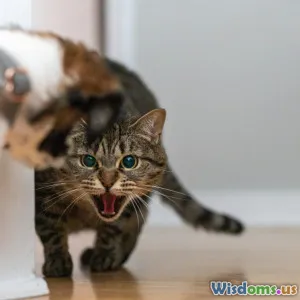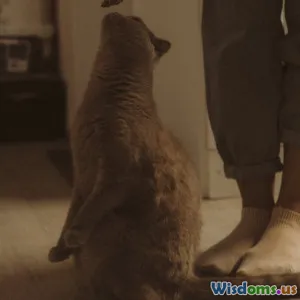
Top Reasons Cats Exhibit Aggressive Behavior and Solutions
7 min read Explore why cats show aggression and effective ways to handle it for happier pets and owners. (0 Reviews)
Top Reasons Cats Exhibit Aggressive Behavior and Solutions
Cats are often celebrated for their independent yet gentle nature. However, an aggressive cat can perplex and distress even the most experienced pet owner. Understanding why your feline might lash out aggressively is crucial—not just to protect yourself but to promote your pet’s well-being.
In this article, we’ll explore the main causes of aggression in cats and provide practical, effective strategies to address this challenging behavior.
Understanding Aggression in Cats
Aggression in cats is not a simple behavior; it ranges from gentle swatting to severe biting. According to a 2018 survey published by the American Veterinary Medical Association, nearly 31% of cat owners report some form of aggressive behavior from their pets. The reasons run the gamut from survival instincts to environmental stresses and health issues.
It's important to note that aggression is a form of communication. When a cat lashes out aggressively, it's often signaling discomfort, fear, pain, or social conflict.
1. Fear-Driven Aggression
Why It Happens
Cats can become aggressive in response to fear. Traumatic past experiences, unfamiliar environments, or sudden changes (like new people or pets) can provoke defensive aggression.
Example: A feral cat introduced into a home environment might attack if it feels cornered.
Solutions
- Safe Spaces: Provide hiding spots such as cats’ condos or covered beds.
- Gradual Introductions: Introduce new family members or pets step-by-step.
- Calming Products: Use pheromone diffusers like Feliway to reduce anxiety.
Veterinarian Dr. Lisa Freeman emphasizes, "Respecting a fearful cat’s need for space is paramount. Forced interaction only escalates aggression."
2. Territorial Aggression
Why It Happens
Cats are territorial by nature. When they perceive an intruder (another pet or even a person) encroaching on their domain, aggressive displays help reaffirm control.
Example: Two male cats in the same household may fight to establish dominance.
Solutions
- Separate Resources: Ensure each cat has separate feeding bowls, litter boxes, and resting areas.
- Controlled Interaction: Slowly reintroduce cats using scent swapping and supervised meetings.
- Environmental Enrichment: Provide enough toys and climbing structures to reduce boredom.
According to a study in the Journal of Applied Animal Welfare Science, territorial aggression decreases significantly when cats have clearly defined and enriched environments.
3. Redirected Aggression
Why It Happens
Redirected aggression occurs when a cat sees a trigger it can't reach (like an outdoor cat) and lashes out at whatever is nearby, often a family member or another pet.
Example: A cat watching birds through the window may suddenly attack a nearby dog.
Solutions
- Interrupt and Redirect: Use toys or treats to direct your cat’s attention.
- Block View: Close curtains or use privacy films to reduce stimuli.
- Exercise: Engage your cat with interactive play sessions to alleviate pent-up energy.
Animal behaviorist Pam Johnson-Bennett advises, "Regular play helps mitigate frustration that often leads to redirected aggression."
4. Pain-Induced Aggression
Why It Happens
A cat in pain may strike out to protect sensitive areas. Common issues include dental problems, arthritis, or injuries.
Example: A normally docile cat reacts aggressively during petting due to arthritis pain.
Solutions
- Veterinary Checkup: Schedule immediate examination to identify and treat medical causes.
- Gentle Touch: Adjust how and where you pet your cat.
- Medication: Pain control under vet guidance can significantly reduce aggression.
Research published in the Journal of Feline Medicine and Surgery found that treating chronic pain in cats led to a noticeable decrease in aggressive behaviors.
5. Play-Related Aggression
Why It Happens
Cats, especially kittens and young adults, often exhibit aggressive play behavior that mirrors hunting instincts. This usually manifests in biting and scratching during interaction.
Example: A kitten biting your hand while playing.
Solutions
- Use Toys, Not Hands: Redirect play aggression to appropriate toys.
- Set Boundaries: Stop playtime immediately if biting or scratching occurs.
- Regular Play: Scheduled, interactive play sessions help expend energy.
Many cat trainers suggest using wand toys and laser pointers to keep the cat engaged and discourage hand-based play aggression.
6. Hormonal or Dominance-Related Aggression
Why It Happens
Unneutered males and females in heat can exhibit increased aggression triggered by hormonal surges.
Solutions
- Spaying/Neutering: Consult with your vet about sterilization.
- Environmental Control: Control outdoor access during heat cycles.
Spaying and neutering not only prevent unwanted litters but also reduce aggressive tendencies, as indicated by research at the Cornell Feline Health Center.
Conclusion
Aggression in cats can be distressing, but understanding its root causes is the first step toward resolution. Whether driven by fear, territorial instincts, pain, or play, each case requires specific management approaches. Patience, careful observation, and sometimes veterinary assistance will not only improve your cat’s behavior but also deepen the loving bond between you.
By applying appropriate solutions tailored to your cat’s unique triggers, you can transform aggression into a more manageable, even absent, issue—allowing both you and your feline friend to enjoy a peaceful, happy coexistence.
References:
- American Veterinary Medical Association Surveys
- Journal of Applied Animal Welfare Science
- Journal of Feline Medicine and Surgery
- Cornell Feline Health Center
Expert quotes:
- Dr. Lisa Freeman, DVM
- Pam Johnson-Bennett, Animal Behaviorist
Rate the Post
User Reviews
Popular Posts




















